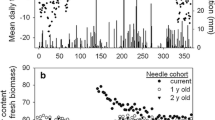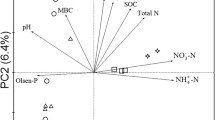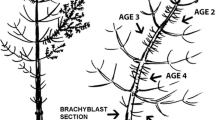Summary
Changes in needle nitrogen and resin acid concentrations in young Scots pine trees fertilized with ammonium nitrate were followed over 3 years. Sawfly larvae (Neodiprion sertifer) were reared on fertilized and control trees the year after fertilization. Both nitrogen and resin acid concentrations increased in fertilized trees. The fact that resin acid concentrations increased contradicts predictions of the carbon/nutrient balance hypothesis. We suggest that needle resin-acid concentrations are limited more by the size of the resin ducts than by the availability of substrate for resin acid synthesis, and that the formation of resin ducts is limited by the availability of nitrogen. A modification of the carbon/nutrient balance hypothesis, relating compartment formation to allelochemical synthesis, is discussed. Performance of sawfly larvae was not affected by fertilization treatment, probably because concentrations of nitrogen (positively affecting performance) and resin acids (adversely affecting performance) increased simultaneously in fertilized trees. Thus, the results of this study do not support the notion that fertilization increases the resistance of trees to needle-eating insects.
Similar content being viewed by others
References
Abrahamson WG, Anderson SS, McCrea KD (1988) Effects of plant carbon nutrient balance on tall goldenrod resistance to a gallmaking herbivore. Oecologia 77: 302–306
Archer TL, Onken AB, Matheson RL, Bynum ED (1982) Nitrogen fertilizer influence on greenbug (Homoptera: Aphididae) dynamics and damage to sorghum. J Econ Ent 75: 695–713
Arnborg T (1964) Det nordsvenska skogstypschemat. 6th edn. Svenska skogsvårdsföreningens förlag, Stockholm (In Swedish)
Aronsson A, Elowson S (1980) Effects of irrigation and fertilization on mineral nutrients in Scots pine needles. In: Persson T (ed) Structure and function of northern coniferous forests—An ecosystem study. Ecol Bull (Stockholm) 32: 269–306
Bohlin E, Hämäläinen M, Sundén T (1989) Botanical and chemical characterization of peat using multivariate methods. Soil Sci 147: 252–263
Bridgen MR (1979) Genetic variation of Scots pine oleoresin physiology. Thesis. Michigan State University, USA
Brodbeck B, Strong D (1987) Amino acid nutrition of herbivorous insects and stress to host plants. In: Barbosa P, Schultz JC (eds) Insect outbreaks. Academic Press, London, pp 347–364
Bryant JP, Chapin FS, Klein DR (1983) Carbon/nutrient balance of boreal plants in relation to vertebrate herbivory. Oikos 40: 357–368
Bryant JP, Clausen TP, Reichardt PB, McCarthy MC, Werner RA (1987) Effect of nitrogen fertilization upon the secondary chemistry and nutritional value of quaking aspen (Populus tremuloides Michx.) leaves for the large aspen tortrix (Choristoneura conflictana (Walker)). Oecologia 73: 513–517
Bryant JP, Tuomi J, Niemelä P (1988) Environmental constraint of constitutive and long-term inducible defenses in woody plants. In: Spencer KC (ed) Chemical mediation of coevolution. Academic Press, London, pp 367–389
Dunn WJ, Wold S, Edlund U, Hellberg S, Gasteiger J (1984) Multivariate structure-activity relationships between data from a battery of biological tests and an ensemble of structure descriptors: The PLS method. Quant Struct-Act Relat 3: 131–137
Faeth SH, Connor EF, Simberloff D (1981) Early leaf abscission: a neglected source of mortality for folivores. Am Nat 117: 409–415
Fernandes GW, Whitham TG (1989) Selective fruit abscission by Juniperus monosperma as an induced defence against predators. Am Midl Nat 121: 389–392
Frantz DP, Wagner MR (in press) Influence of induced water stress in Ponderosa pine on pine sawflies. Oecologia
Gershenzon J (1984) Changes in the levels of plant secondary metabolites under water and nutrient stress. Rec Adv Phytochem 18: 273–320
Gref R (1981) Variation in isoabienol content in Pinus sylvestris needles. Can J Bot 59: 831–835
Gref R (1982) Diterpenoids and some water-soluble compounds of Pinus sylvestris and their possible relationship to resistance to fungal parasites. Thesis. Swedish Univ Agric Sci, Umeå, Sweden
Gref R, Ericsson A (1985) Wound induced changes of resin acid concentrations in living bark of Scots pine seedlings. Can J For Res 15: 92–96
Grimalskij VI (1961) The cause of the resistance of pine stands to needle-eating pests. Zool Zh 40: 1656–1664 (In Russian)
Grime JP (1979) Plant strategies and vegetation processes. John Wiley, Chichester
Hanover JW (1975) Physiology of tree resistance to insects. Ann Rev Ent 20: 75–95
Heliövaara K, Terho E, Annila E (1983) Effect of nitrogen fertilization and insecticides on the population density of the pine bark bug, Aradus cinnamomeus (Heteroptera, Aradidae). Silva Fenn 17: 351–357
Ikeda T, Matsamura F, Benjamin DM (1977) Mechanism of feeding discrimination between matured and juvenile foliage by two species of pine sawflies. J Chem Ecol 3: 677–694
Larsson S, Tenow O (1984) Areal distribution of a Neodiprion sertifer Geoffr (Hym, Diprionidae) outbreak on Scots pine as related to stand condition. Holarct Ecol 7: 81–90
Larsson S, Björkman C, Gref R (1986a) Responses of Neodiprion sertifer (Hym, Diprionidae) larvae to variation in needle resin acid concentration in Scots pine. Oecologia 70: 77–84
Larsson S, Wirén A, Lundgren L, Ericsson T (1986b) Effects of light and nutrient stress on leaf phenolic chemistry in Salix dasyclados and susceptibility to Galerucella lineola (Coleoptera). Oikos 47: 205–210
McKey D (1979) The distribution of secondary compounds within plants. In: Rosenthal GA, Janzen DH (eds) Herbivores: their interaction with secondary plant metabolites. Academic Press, New York, pp 55–133
McNeill S, Southwood TRE (1978) The role of nitrogen in the development of insect/plant relationships. In: Harborne JB (ed) Biochemical aspects of plant and animal coevolution. Academic Press, London, pp 77–98
Martens H, Naes T (1989) Multivariate calibration. John Wiley, New York
Mattson WJ (1980) Herbivory in relation to plant nitrogen content. Ann Rev Ecol Syst 11: 119–161
Mihaliak CA, Lincoln DE (1985) Growth pattern and carbon allocation to volatile leaf terpenes under nitrogen-limiting conditions in Heterotheca subaxillaris (Asteraceae). Oecologia 66: 423–426
Mihaliak CA, Couvet D, Lincoln DE (1989) Genetic and environmental contributions to variation in leaf mono- and sesquiterpenes of Heterotheca subaxillaris. Biochem Syst Ecol 17: 529–533
Muzika RM, Pregitzer KS, Hanover JW (1989) Changes in terpene production following nitrogen fertilization of grand fir (Abies grandis (Dougl.) Lindl.) seedlings. Oecologia 80: 485–489
Myers JH, Post BJ (1981) Plant nitrogen and fluctuations of insect populations: a test with the cinnabar moth—tansy ragwort system. Oecologia 48: 151–156
Näsholm T, Ericsson A (1990) Seasonal changes in amino acids, protein and total nitrogen in needles of Scots pine trees. Tree Physiol in press
Näsholm T, Sandberg G, Ericsson A (1987) Quantitative analysis of amino acids in conifer tissues by high-performance liquid chromatography and fluorescence detection of their 9-fluorenylmethyl chloroformate derivatives. J Chromatogr 396: 225–236
Niemelä P, Mannila R, Mäntsälä P (1982) Deterrent in Scots pine, Pinus sylvestris, influencing feeding behaviour of the larvae of Neodiprion sertifer (Hymenoptera, Diprionidae). Ann Ent Fenn 48: 57–59
Ohigashi H, Wagner MR, Matsamura F, Benjamin DM (1981) Chemical basis of differential feeding behaviour of the larch sawfly Pristiphora erichsonii (Hartig). J Chem Ecol 7: 599–614
Oldiges H (1958) Waldbodendüngung und Schädlingsfauna des Kronenraumes. Allg Forstz 13: 138–140
Otto D, Geyer W (1970) Zur bedeutung des Kiefernnadelharzes und des Kiefernnadelöles für die Entwicklung nadelfressender Insekten. Arch Forstwes 19: 151–167
Popp MP, Kulman HM, White EH (1986) The effect of nitrogen fertilization of white spruce (Picea glauca) on the yellowheaded spruce sawfly (Pikonema alaskensis). Can J For Res 16: 832–835
Prestidge PA, McNeill S (1983) The importance of nitrogen in the ecology of grassland Auchenorrhyncha. Symp Brit Ecol Soc 22: 257–281
Price PW, Cobb N, Craig T, Fernandes W, Itami J, Mopper S, Preszler R (in press) Insect herbivore population dynamics on trees and shrubs: new approaches relevant to latent and eruptive species. In: Bernays E (ed) Focus on insect-plant interactions. Vol 3, CRC Press, Boca Raton, Florida
Schuh BA, Benjamin DM (1984) The chemical feeding ecology of Neodiprion dubiosus Schedl, N. rugifrons Midd. and N. lecontei Fitch on jack pine (Pinus banksiana Lamb.). J Chem Ecol 10: 1071–1079
Scriber JM, Slansky F (1981) The nutritional ecology of immature insects. Ann Rev Ent 26: 183–211
Stark RW (1965) Recent trends in forest entomology. Ann Rev Ent 10: 303–324
Strong DR, Lawton JH, Southwood R (1984) Insects on plants: community patterns and mechanisms. Blackwell, Oxford
Tamm CO (1955) Studies on forest nutrition. I. Seasonal variation in the nutrient content of conifer needles. Medd Statens Skogsforskningsinst 45: 1–34
Wagner MR, Benjamin DM, Clancy KM, Schuh BA (1983) Influence of diterpene resin acids on feeding and growth of larch sawfly Pristiphora erichsonii (Hartig). J Chem Ecol 9: 119–127
Waring RH, McDonald AJS, Larsson S, Ericsson T, Wirén A, Arwidsson E, Ericsson A, Lohammar T (1985) Differences in chemical composition of plants grown at constant relative growth rates with stable mineral nutrition. Oecologia 66: 157–160
Weibull J (1987) Resistance in the genera Avena and Hordeum to the aphid Rhopalosiphum padi (L.)—genetic resources and nutritional aspects. Thesis, Swedish Univ Agric Sci, Uppsala, Sweden
White TCR (1974) A hypothesis to explain outbreaks of looper caterpillars, with special reference to populations of Selidosema suavis in a plantation of Pinus radiata in New Zealand. Oecologia 16: 279–301
Author information
Authors and Affiliations
Rights and permissions
About this article
Cite this article
Björkman, C., Larsson, S. & Gref, R. Effects of nitrogen fertilization on pine needle chemistry and sawfly performance. Oecologia 86, 202–209 (1991). https://doi.org/10.1007/BF00317532
Received:
Accepted:
Issue Date:
DOI: https://doi.org/10.1007/BF00317532




